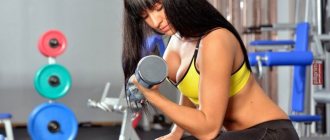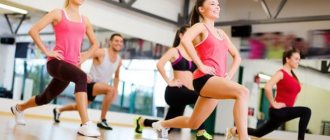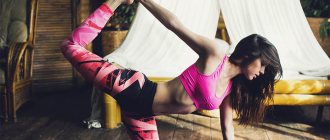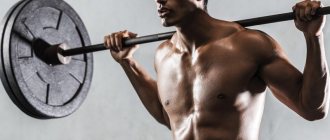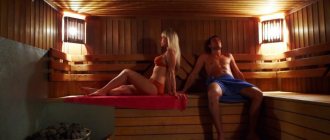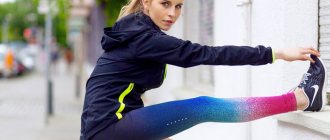Progress and muscle growth have stopped, but have you ever wondered what this is connected with? Have you ever noticed that some girls and men stretch after training? Perhaps you have already lost the logical relationship, what does muscle growth and stretching have to do with it? There is an established opinion that stretching is done to increase flexibility or splits in order to demonstrate the basics of rhythmic gymnastics, but this is far from true. Stretching is not just part of a workout for those who have nothing to do in the gym, but an important component of strength training for both women and men.
Use the principle of uniformity
The first principle of proper stretching is uniformity. For convenience and clarity, Lifehacker will analyze it using the example of myofascial meridians (lines) described in the book “Anatomical Trains” by Thomas Myers.
Why is it important to stretch your body evenly?
By stretching just one part of your body, such as your hamstrings, you risk developing poor posture.
The fact is that the muscles in the human body are not isolated from each other, so stretching or contracting one muscle affects others.
Groups of muscles and fascia that are interconnected and transmit tension are called myofascial meridians.
Hypertonicity or, conversely, overstretching of one or more muscles in the myofascial line leads to poor posture and problems with the spine.
Two myofascial meridians are responsible for posture, flexion and straightening of the body: the superficial posterior line (SPL) and the superficial frontal line (SFL).
On the left is the superficial posterior line, on the right is the superficial frontal line
The function of the superficial posterior line is to keep the body straight and prevent it from twisting when flexed.
If this line is short, it prevents the body from bending forward: for example, when a person cannot reach his toes with his hands without bending his knees.
If the PCL muscles are overstretched, this causes problems with the spine. For example, hyperextension of the knees can increase lumbar lordosis and sag in the neck.
Here are some yoga exercises to stretch the muscles of the superficial posterior line.
Superficial back line stretching / hanuman.ru
Another line is also involved in the formation of correct posture - the superficial frontal line. Its main function is to maintain balance with the superficial back line.
Here are asanas in which the PFL muscles are stretched.
Stretching the superficial frontal line / hanuman.ru
Stretched muscles / hanuman.ru
Since two lines regulate the position of the body in space, when stretching you need to pay attention to both of them.
How to stretch your body evenly
To stretch all the muscles of the body evenly, you can use the asanas presented above, or simply select stretching exercises in accordance with the principle of uniformity.
If you do hamstring stretching exercises (leg bends, elevated stretches), it is worth including rectus femoris stretches (quadriceps stretches against the wall, on the knee).
If you stretch the erector spinae muscles, for example by performing a leg tuck, you also need to stretch the rectus abdominis muscles: in sit-ups, lying on your stomach, bridges, or other exercises.
Biceps stretch
Stretching these muscles is one of the main factors in their growth. Thanks to stretching, blood supply to the biceps improves and muscle recovery occurs much faster.
Biceps stretching exercises
1. Stand straight, place your feet shoulder-width apart, clasp your hands behind your back so that your palms face down. In this position, raise your arms up without bending your elbows. Keep your body straight and feel the stretch in your biceps.
Biceps stretch
2. Stand with your back to the door frame or horizontal bar post. Reach your hand back and grasp the joint with your thumb pointing up. Next, try to turn your arm with your biceps down, while keeping your hand in place. Switch hands and do the same.
3. To perform the next exercise you will need a horizontal bar. Grab it with a reverse grip and hang with your arms outstretched for as long as possible.
Consider your lifestyle
Our body is designed to be in motion, and not to remain frozen in one place for a long time, especially when sitting.
When you sit, some muscles of the body are overly stretched, while others, on the contrary, are in constant tone. This spoils your posture and causes problems with the spine. And the first common problem among those who lead a sedentary lifestyle is weak, overstretched muscles in the back of the thigh.
How to fix a hyperstretched hamstring muscle
When you sit, the muscles of the back of the thigh are constantly in a stretched and elongated position. Because of this, a natural need to contract arises and the muscles feel stiff.
Many people, feeling the stiffness of their hamstrings, believe that they need to be properly stretched. In fact, this can only aggravate the problem: the already excessively elongated femoral biceps will become even stiffer from stretch to stretch.
The solution is to massage the problem area, which you can do yourself by rolling out the hard biceps of the thigh on a massage roller or barbell. When you relax your muscles a little, you can stretch them during strength exercises: deadlifts, squats, lunges.
In addition, a sedentary lifestyle is often the cause of a shortened iliopsoas hip flexor muscle.
Iliopsoas stretch
Unlike a stretched hamstring, the iliopsoas muscle becomes too short. It pulls the vertebrae of the lumbar spine forward, which causes an unhealthy arch in the lower back (hyperlordosis).
Therefore, if you have a sedentary job, be sure to spend time stretching your iliopsoas muscle.
Iliopsoas stretch / enhancephysiotherapy.net.au
Forearm stretch
Forearm stretching exercises
1. Stand with your back to the doorway. Straighten your left arm and raise it to mid-waist level. Grasp the joint with your left hand, thumb pointing down. Rotate your arm outward, trying to keep your biceps at the top.
Recommendations: This exercise can be performed while holding onto a vertical support. Don't bend your elbow. To increase the degree of stretching, turn the inner surface of the arm upward, while simultaneously turning the body to the right.
2. Get on all fours. Your toes should point outward and your fingers should point toward your knees. With your palms flat on the floor, lean back to stretch the front of your forearms. Hold a gentle stretch for 15-20 seconds. Relax and then stretch again.
Tips: When performing upper body stretches, bend your knees slightly.
3. Stretch your arms above your head, placing your palms together, stretch your arms up and slightly back. Inhale as you stretch. Hold the stretch for 5-8 seconds without holding your breath. This is an excellent exercise for the muscles on the outer arms, shoulders and chest. It can be performed anytime and anywhere to relieve tension, achieve a feeling of relaxation and well-being.
Recommendations: Perform the exercises presented every time after strength training. Remember that only regular training gives visible results. Alternate exercises, combine them with others.
Try to stretch your muscles one at a time, paying attention to each muscle group, this will reduce the risk of injury during training.
Sincerely, Arina Klishina
Strengthen your muscles to make stretching safer
For a trained person, stretching is safer: if you have strong muscles, the risk of sprains is reduced and progress is accelerated.
The fact is that the ability of a muscle to stretch depends mainly on connective tissue - collagen fibers and their elasticity. Exercise reduces the number of collagen cross-links that make muscle stiffer, especially as you age. Therefore, trained muscles are better stretched, and the risk of spraining ligaments and tendons during stretching is reduced.
This means that if you decide to improve your flexibility, you should include strength exercises in your training.
And the last factor that needs to be taken into account when composing a stretching routine is which muscles were involved in the workout.
Why do you need to stretch after a workout?
Flexibility of muscles and ligaments is not just the aesthetics of physical development that girls strive for, but the main tool of any athlete, which contributes to the speedy recovery of all muscles.
Here is the mechanism of action: under load, the muscles contract and shorten; one might say, they become more and more compressed with each workout and worse or do not return to their normal state at all. Such muscles become overloaded and inelastic. It is these muscles that stop growing, since the full range of motion is important for their growth, and the stretching phase (negative) is no less important here than the contraction phase.
So, when muscles are stretched, they are prevented from shortening and normal levels of recovery are maintained. And recovery is known for its effect on accelerating anabolism. Thus, by stretching after training, the muscles will be able to rest faster, maintaining elasticity and physiological state, constantly improving the amplitude of movement, and accordingly, the muscles will grow faster.
Stretch the muscles that have been working
By stretching your muscles, you improve tissue nutrition, increase blood circulation and even increase strength. One study of Chronic Static Stretching Improves Exercise Performance. showed that regular muscle stretching, even without other exercise, increases strength and strength endurance.
For 10 weeks, participants in one group stretched their leg muscles for 40 minutes several times a week. After this, their one-time max for calf raises and lowering exercises on machines increased by 32%, and their muscular endurance—the number of repetitions they could perform before the muscles failed—by 60%.
Thus, stretching not only improves metabolic processes in tissues, but also helps to become stronger.
After training, pay special attention to the muscles that were involved in the exercises, and also stretch the opposing muscle groups.
Let's give an example.
If your workout consisted of weighted lunges, deadlifts, push-ups, and dumbbell rows, you are stretching:
- pectoral muscles;
- hamstrings and quadriceps;
- buttocks;
- triceps and biceps of the arms;
- latissimus dorsi muscles;
- trapezius muscles.
Stretching exercises can be viewed in this article or in a video based on it.
Precautionary measures
If done incorrectly, loaded stretches can be dangerous, so use moderate weights, pay attention to the angle of the stretch, and abduct your limbs just enough to feel the stretch in the target muscle , but not in the joints or ligaments.
Additionally, stretching should be performed at the end of your workout. Performing it early, research shows, has a negative effect on its effectiveness .
One review in the Journal of Clinical Sports Medicine published the results of 20 studies that showed that vigorous stretching performed before exercise worsens performance. This was observed in terms of endurance, jump height, as well as jump strength and speed.
Thus, it is better to leave stretching for a later phase of training , when you finish off the muscles.
conclusions
So, to create a post-workout stretching routine, use the following diagram.
- Mark the target muscle groups that were involved in the workout.
- Choose a stretching exercise for each group.
- Incorporate stretches for muscle groups from the opposite myofascial line to balance the complex.
- Perform each stretching exercise for 90–120 seconds (during this time the fascia has time to get used to the new position).
That's all. If you have your own tips and comments about stretching after a workout, share them in the comments.
Muscle stretching exercises in the gym
The best list of exercises for stretching muscles after strength training in the gym.
Buttock, back and obliques
Buttocks, back, oblique muscles
Lie on your back, stretch out, bend your left leg at the knee and smoothly, without rushing, begin to pull it towards your right side. In the extreme, taut position, hold the bent leg at the knee for a few seconds , feel a slight tension in the muscles and ligaments. Perform this exercise in 2 sets of 3 repetitions on each leg.
Buttocks, back, oblique muscles
Remain lying on your back, straighten your right arm perpendicular to your body, begin to pull your leg bent at the knee with your left hand onto your right side and onto the floor, while watching your pelvis so that it does not completely roll over to the right side, otherwise this will have no effect. way to stretch the gluteal muscles . When performing the exercise, do not lift your head, shoulders and supporting arm from the floor.
Groin and hip adductors
Groin and adductor muscles of the thigh
Lying on your back, straighten your arms along your body, bend your knees, bring your feet together, relax.
in this relaxed state for 1 minute, under the influence of gravity your muscles will stretch, as you train, reduce the distance between the pelvis and the turned out feet, and also to enhance the stretching effect, smoothly and without fanaticism , press your hands on your hips.
Spine
Spine
Lie on your stomach, pull your arms up to your head, lean on your forearms, so that your torso is slightly bent in the spine, at the angle you need. In this bent position, relax, hold for 20 seconds, feel a light, pleasant load in your lower back . Repeat this exercise 3-4 times.
While in the same position, pull your forearms towards your chest and shoulders, straighten your arms at the elbow joint, your back should arch, you will feel tension in the pelvis and lower back, relax them.
Spine
As you train, increase the angle of deviation of the torso from the horizontal, as well as the time the relaxed pelvis and lower back are under load.
This exercise helps in preventing a healthy spine .
Hip flexors
While standing, lower the knee of your right leg to the floor, while the knee of your right leg should be pushed forward.
Hip flexors
Make sure that your right knee, shoulder, and hip joint are in line. Adjust the degree of tension in the front of your right thigh by moving your pelvis forward.
Do 5-10 swings for one leg.
Posterior thigh
To perform this exercise you will need a Swedish ladder . Raise your right leg to the required height, while the left leg, like the right, should be fully straightened at the knee.
Posterior thigh
Do 10-15 swings towards the foot of your right leg. Make sure that the left leg is fully straightened at the knee joint , and the direction of the knee should coincide with the direction of the foot. As you train, increase the height of the leg lift, as well as the amplitude of the swings.
A fairly common exercise when a person sits on the floor, with his legs straightened at the knees, and performs smoothly rhythmic bends of the torso towards the toes. You may mistakenly think that this exercise stretches the hamstrings , but in reality it is aimed at improving the flexibility of the spine.
Quadriceps and knees
Quadriceps and knees
Find support, rest your left hand on it so that your body is completely straight, bend your left leg at the knee, and with your right hand grab your left ankle and pull it up.
As you practice, you will learn to pull your heel towards your buttocks , but do not strive to develop extreme flexibility in this exercise, due to the fact that there is a high probability of stretching the knee tendon. Switch legs and repeat the exercise.
Keep in mind that beginners in this exercise often confuse the order of actions: the left ankle is pulled up with the left hand, and vice versa, the right ankle is pulled up with the right hand.
Quadriceps and knees
And this, in turn, has a destructive effect on the knee joint due to the unnatural bend.
To perform this exercise more safely, do the same thing only while lying down.
Spine, back, neck and shoulders
Spine, back, neck, shoulders
Find a chair or something similar, such as a bench with a back, sit sideways to the back. Holding your pelvis and legs, make a motionless turn with your torso , point your shoulders and head in the same direction, apply the necessary effort to the back of the chair for a stretching effect, stay in this position for a couple of seconds.
Sit on the other side and repeat this exercise. The increase in the amplitude of the stretching movement should occur smoothly and gradually.
Neck
Neck
Sit on a chair, straighten your back, look straight ahead.
In this position, tilt your chin down and turn your head first in one direction, then in the other, slightly helping with your hand to ensure the desired stretch of the neck.
Do 3-4 reps on each side.
Neck
Legs and lower back
Sit on the cards, with both hands press first on your right knee, then on your left knee, imagine as if you want to remove the weight from your knees .
In this simple way, you can achieve full amplitude bending of your knees, and this in turn will keep them healthy.
Legs and lower back
Squat down so that your buttocks touch the floor. Hold the lower position for 20 seconds and stand up.
Perform 2 sets of 2 reps. This exercise puts quite a lot of stress on the knee joint, so it is recommended that you first help yourself with your hands at the lowest point.
Shoulders and chest
To complete this exercise you will need a doorway, or something similar to it. Approach so that your socks are at a distance of 7-8 cm from the doorway and rest your bent arms against the wall or door frames, as shown in the figure.
Shoulders and chest
The optimal angle of flexion at the elbow joint is about 90-100 degrees , make sure that your shoulders are parallel to the floor. As you lean your body forward, you will experience a slight stretch in your shoulders and chest.
In order to progress in this exercise, you need to stand up each time a little further from the doorway , while your hands should remain in the same place, thus, when you bend forward, you will experience more and more tension in the shoulder girdle.
Do this exercise with caution to avoid straining your pectoral and shoulder muscles.
Achilles tendon
Achilles tendons
Find a step of the required height to perform the exercise in full amplitude. Place your right foot on the step and shift your body weight; only the front of your foot . the Achilles tendon stretch . Change your leg.
We need flexible Achilles tendons so that we can squat in regular shoes, with a normal heel, without the need to place weights or other objects under the heel.
Post-workout spinal stretch
Hang on the bar , grip shoulder-width apart, you should relax your lower body and feel your vertebrae straighten, fatigue leaving your lower back.
Spine
Do not jump off the bar abruptly, you may injure your spine.
Be sure to perform this exercise after heavy, compound exercises such as deadlifts and squats, and indeed after any other exercises that place significant compressive load on the spine.
If you want to stretch your spine at different angles, then simply raise your knees to waist and smoothly rotate your hips.
If your gym has equipment for hanging upside down , you can use it instead of hanging on the bar.
Spine
Find two pillows, lie on the floor and place them under your pelvis, while relaxing your lower back as much as possible, lie there for about 1 minute . When performing the exercise correctly, you will feel a release in the lumbar region.
When you finish doing this exercise, do not lift your torso , you can easily injure your spine, just roll onto your side and stand up.
Shoulders, arms and chest
Shoulders, arms and chest
Twists are an exercise for those who want to hold the barbell as low as possible on the trapezius during squats.
With both hands, take a stick or a towel, as shown in the figure, spread your legs shoulder-width apart, straight back, begin to raise your straightened arms at the elbows above your head and lower them behind your head as low as possible, this will count as one repetition .
Shoulders, arms and chest
As you train, reduce the distance between your hands, do three sets of 10-15 repetitions .
This list of exercises is a universal scheme for stretching after a workout.
Take your time to do all the exercises at once; first of all, stretch the muscles that you trained in the gym.
